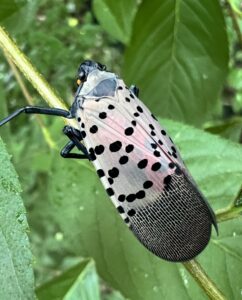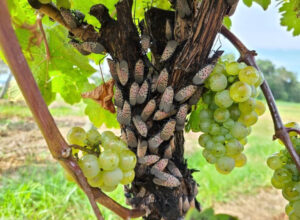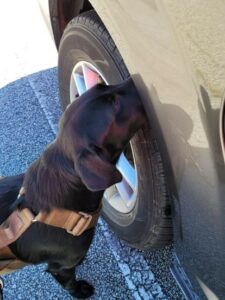New Neighbors: Spotted Lanternfly in Rockingham County
go.ncsu.edu/readext?1073419
en Español / em Português
El inglés es el idioma de control de esta página. En la medida en que haya algún conflicto entre la traducción al inglés y la traducción, el inglés prevalece.
Al hacer clic en el enlace de traducción se activa un servicio de traducción gratuito para convertir la página al español. Al igual que con cualquier traducción por Internet, la conversión no es sensible al contexto y puede que no traduzca el texto en su significado original. NC State Extension no garantiza la exactitud del texto traducido. Por favor, tenga en cuenta que algunas aplicaciones y/o servicios pueden no funcionar como se espera cuando se traducen.
Português
Inglês é o idioma de controle desta página. Na medida que haja algum conflito entre o texto original em Inglês e a tradução, o Inglês prevalece.
Ao clicar no link de tradução, um serviço gratuito de tradução será ativado para converter a página para o Português. Como em qualquer tradução pela internet, a conversão não é sensivel ao contexto e pode não ocorrer a tradução para o significado orginal. O serviço de Extensão da Carolina do Norte (NC State Extension) não garante a exatidão do texto traduzido. Por favor, observe que algumas funções ou serviços podem não funcionar como esperado após a tradução.
English
English is the controlling language of this page. To the extent there is any conflict between the English text and the translation, English controls.
Clicking on the translation link activates a free translation service to convert the page to Spanish. As with any Internet translation, the conversion is not context-sensitive and may not translate the text to its original meaning. NC State Extension does not guarantee the accuracy of the translated text. Please note that some applications and/or services may not function as expected when translated.
Collapse ▲
Spotted lanternfly adult. Photo by Kelly Oten, NC State.
Rockingham County just got an unwelcome new resident — spotted lanternfly (SLF). This isn’t just any insect; it’s an invasive pest from southeast Asia that’s been steadily spreading across the United States since it was first found in Pennsylvania in 2014. It likely made its way here, like many other invasive species, by catching a ride on imported goods. Its continued spread happens primarily through people accidentally moving it, as it is known to hitch rides on vehicles or outdoor items.
The North Carolina Department of Agriculture and Consumer Services (NCDA&CS) confirmed this new population on May 21, 2025. Initial findings show them clustered within about a 2-mile area in Reidsville, but surveys are still ongoing to see if they’ve spread further. This makes Rockingham the third county in North Carolina to have an established population, following Forsyth and Guilford Counties, where they were detected in June 2022.

Spotted lanternfly on grapevine. Photo by Heather Leach, Penn State.
So, why is this little insect such a big concern? SLF is quite a threat to plants. It feeds on over 100 different plants, including many trees and plants you might have in your yard. While they prefer another invasive plant, the tree-of-heaven, their impact is particularly devastating for grapevines, causing up to 90% yield reduction or even killing them entirely in heavily infested vineyards. They also target fruit trees like apples and cherries, hops, and various ornamental plants.
Beyond the damage to plants, they are a real nuisance to people. They often gather in large numbers near homes and businesses. As they feed, they excrete a sticky substance called “honeydew,” which attracts stinging insects and leads to the growth of black sooty mold on surfaces, which can be unsightly and, in large amounts, can potentially harm plants by blocking sunlight. Unfortunately, SLF don’t have many natural enemies here, which lets their populations grow rapidly.
NCDA&CS has sprung into action! They have been actively watching for this pest in the Triad area since that first find in Kernersville in 2022. Now, with the confirmation in Rockingham, their efforts are intensifying.

Kita, one of two spotted lanternfly detector dogs in NC, sniffs a wheel well in pursuit of SLF, which can be very hard to find and are easily transported in any life stage. Photo by Kelly Oten, NC State.
Teams from the Plant Industry Division are working quickly to survey and treat areas to prevent SLF from spreading further. They may contact property owners for request permission to survey and, if needed, treat the infestation. Believe it or not, they also have spotted lanternfly detector dogs helping them find the invaders!
For treatment efforts, priority is given to locations where SLF are most likely to be inadvertently transported to new areas—such as commercial sites engaged in interstate trade and areas undergoing development. Three main treatment strategies are employed:
-
Knock-down treatments are used to eliminate small, concentrated populations. This involves the application of the same insecticide commonly used for termite control in residential settings.
-
Host removal targets tree-of-heaven, the SLF’s preferred host, by applying herbicides to remove these trees.
-
Systemic insecticide treatments are applied to tree-of-heaven, ensuring that any SLF feeding on treated trees will ingest the toxin and die.
How You Can Help in the Fight
As residents, you play a vital role in monitoring for and helping to control this pest.
- Be on the lookout: Learn what SLF looks like in its different life stages. Be sure to compare it with some of our look-alikes! If you think you’ve seen one in North Carolina, be sure to “see it, snap it, report it” — submit a picture through the online reporting tool. This helps officials track the infestation.
- Check your vehicles before you travel: SLF are notorious hitchhikers. If you are leaving an area known to have them, take a moment to check yourself, your vehicle, and anything you might be transporting that has been stored outdoors – like firewood, grills, or patio furniture. Removing any stage of SLF you find can help prevent their spread. It’s also recommended to burn untreated firewood within 50 miles of where it was cut or use heat-treated wood.
- Cooperate with Officials: If NCDA&CS staff contact you, allowing them access to survey and potentially treat your property is crucial for the community’s overall control efforts.
If you live in or near Rockingham County and want guidance on managing spotted lanternflies on your own property, your local Cooperative Extension Office is a key resource. There are management guides (and other resources) available at our NC State Extension SLF landing page. Keep in mind that hiring a private pest control company for treatment would be at your own expense.
Always remember, if you use any chemical treatments, you must read and follow the product label carefully – the label is the law!
And please, if you spot this distinctive bug anywhere in North Carolina — See it, Snap it, Report it!


